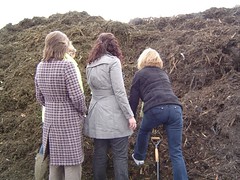Dangerously organic!

Today, McRorie Community Gardeners talked about composting. Maura said "When I was bringing my compost to the garden yesterday, I noticed a rat (I think) in the compost heap. I don't want to be supplying rats with a food source (in consideration of the neighbors, among other reasons). I'm wondering if anyone has any rodent free compost container ideas. I think we could create a lot of good soil (w/o weeds) if there was a good place to put our compost. I suggest not putting any compost at the garden until something has been created for it. Please reply to all, as this can create more of a community effort.Thanks, Maura" This sparked a lively conversation...
I replied, "There's an Earth Machine composter for sale locally. The Earth Machine site says many municipalities have them available either free or discounted. I wonder if the city of Gainesville has these."We discovered that Alachua County has free wire bins for composting. "ALACHUA COUNTY, FL - The Alachua County Office of Waste Alternatives invites the public to their annual Earth Machine compost bin sale at the new Home Depot, located at 5150 N.W. 13th St. in Gainesville. The sale will take place Saturday, April 5, 8 a.m. - 4 p.m. Earth Machines will be available for $34 (including tax), discounted from the retail value of $100. The Earth Machines will be sold on a first-come, first-served basis.
Earth Machines are practical for backyard composting of kitchen scraps and yard waste. Wire compost bins are always available free of charge from the Office of Waste Alternatives.
For more information about the Earth Machine sale, composting, or how to pick up a free wire bin, please contact the Alachua County Office of Waste Alternatives at 352-374-5213, or visit www.thewastewatcher.com. "
Kathy Henderson replied, "Hello All: Michael's suggestion is good, especially if we could get something free. But it seems like the amount of compost we generate would require us to have quite a few of those smaller containers. I wonder if making 2-3 sturdy, rodent proof wooden bins would be effective. We can get wood/supplies from ReUser (622 SE 2nd Street Gainesville, FL, 32601 OPEN TUES-FRIDAY 10:00-5:30 SAT 10:00-3:00 ) very cheaply and if everyone in the garden pitches in for supplies it won't cost anyone very much. Then we can have a work day or two to get them put together. This would probably involve the use of some tools and a few folks who have some building skill. I think the below structure could be an option, although I am sure there are lots of good designs out there. I think it would be good if we can move compost from one bin to another to accelerate decomposition. Maura mentioned to me the other day that she thought hardware cloth would keep rats out, the walls below could be wood though instead of the cloth . . . Wood and wire three-bin turning unit
A wood and wire three-bin turning unit can be used to quickly compost large amounts of yard, garden and kitchen wastes. Although relatively expensive to build, it is sturdy, attractive and should last a long time. Construction requires basic carpentry skills and tools.
Materials
Four 12-foot lengths of pressure-treated 2 x 4 lumber
Two 10-foot lengths of pressure-treated 2 x 4 lumber
One 10-foot length of construction-grade 2 x 4 lumber
One 16-foot length of 2 x 6 lumber
Six 8-foot lengths of 1 x 6 lumber
A 22-foot length of 36-inch-wide 1/2-inch hardware cloth
16d galvanized nails (2 pounds)
Poultry wire staples (250)
Twelve 1/2-inch carriage bolts, 4 inches long, with washers and nuts
One quart wood preservative or stain
Materials for optional lids
One 4-x-8-foot sheet of 1/2-inch exterior plywood
One 4-x-4-foot sheet of 1/2-inch exterior plywood
Six 3-inch zinc-plated hinges
Twenty-four 3/16-inch galvanized steel bolts, with washers and nuts
Tools
Tape measure
Hand saw or circular power saw
Hammer
Tin snips
Carpenter's square
Drill with 3/16-inch and 1/2-inch bits
Screwdriver
Adjustable wrench
Pencil
Safety glasses, ear protection, dust mask, and work gloves
To build a wood and wire three-bin system:
Cut two 31-1/2-inch and two 36-inch pieces from a 12-foot length of pressure-treated 2 x 4 lumber. Butt-joint and nail the four pieces into a 35-inch x 36-inch "square" (Figure 3b). Repeat, building three more frames with the remaining 12-foot lengths of 2 x 4 lumber.
Cut four 37-inch lengths of hardware cloth. Fold back the edges of the wire 1 inch. Stretch the pieces of hardware cloth across each frame. Make sure the corners of each frame are square and then staple the screen tightly into place every 4 inches around the edge. The wood and wire frames will be dividers in your composter.
Set two dividers on end, 9 feet apart and parallel to each other. Position the other two dividers so that they are parallel to and evenly spaced between the end dividers. Place the 36-inch edges on the ground. Measure the position of the centers of the two inside dividers along each 9-foot edge.
Cut a 9-foot piece from each 10-foot length of pressure-treated 2 x 4 lumber. Place the two treated boards across the tops of the dividers so that each is flush against the outer edges. Measure and mark on the 9-foot boards the center of each inside divider.
Line up the marks, and through each junction of board and divider, drill a 1/2-inch hole centered 1 inch from the edge. Secure the boards with carriage bolts, but do not tighten them yet. Turn the unit so that the treated boards are on the bottom.
Cut one 9-foot piece from the 10-foot length of construction-grade 2 x 4 lumber. Attach the board to the back of the top by repeating the process used to attach the base boards. Using the carpenter's square, or measuring between opposing corners, make sure the bin is square. Tighten all the bolts securely.
Fasten a 9-foot length of hardware cloth to the back side of the bin, with staples every 4 inches around the frame.
Cut four 36-inch-long pieces from the 16-foot length of 2 x 6 lumber for front runners. (Save the remaining 4-foot length.) Rip-cut two of these boards to two 4-3/4-inch-wide strips (save the two remaining strips).
Nail the 4-3/4-inch-wide strips to the front of the outside dividers and baseboard so that they are flush on the top and the outside edges. Center the two remaining 6-inch-wide boards on the front of the inside dividers flush with the top edge and nail securely (Figure 3c).
Cut the remaining 4-foot length of 2 x 6 lumber into a 34-inch-long piece, and then rip-cut this piece into four equal strips. Trim the two strips saved from Step 8 to 34 inches. Nail each 34-inch strip to the insides of the dividers so that they are parallel to, and 1 inch away from, the boards attached to the front. This creates a 1-inch vertical slot on the inside of each divider.
Cut the six 8-foot lengths of 1 x 6 lumber into 18 slats, each 31-1/4 inches long. Insert the horizontal slats, six per bin, between the dividers and into the vertical slots.
(Optional) Cut the 4-x-8-foot sheet of exterior plywood into two 3-x-3-foot pieces. Cut the 4-x-4-foot sheet of exterior plywood into one 3-x-3-foot piece on one of the three bins, and attach each to the back, top board with two hinges.
Stain all untreated wood."
Daniel Godwin replied, "Let me also suggest repurposing shipping pallets for this: the wood is generally untreated, so there's nothing to leech, and most folks give them away."
Wow!
Meanwhile, I ran across a podcast called The Alternative Kitchen Garden ...with an episode on composting that you can listen to on your computer or your iPod.

This was all too good to let dissipate in the email ether...so, now we have a record of the info. Feel free to join in on this discussion about McRorie, or your local community garden.
© 2025 Created by Michael Levin.
Powered by
![]()





